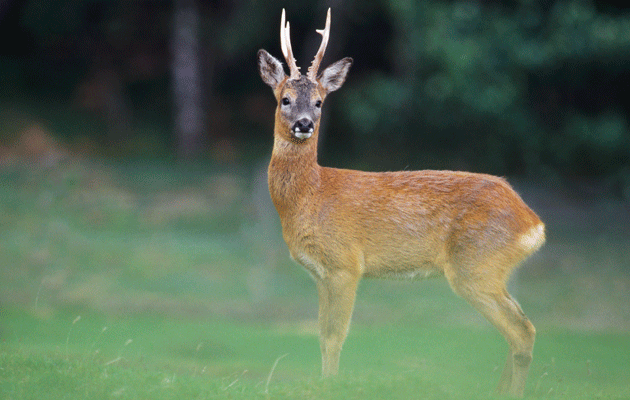English and Welsh roe heads review 2014
In terms of roe heads, last year proved to be a quality one for medal-winners, as Tony Dalby-Welsh reports

Roe buck
Last November, new guidelines for the European species within the CIC’s Red Book — the “bible” of international trophy measuring — were published for internal use. The changes, in principle, will provide greater consistency of measuring throughout a species’ range and provide the trophy judges with clearer technical information. These changes are the culmination of 10 years’ work, collating data from across Europe on the species concerned and conducting research into some of the previously contentious areas of trophy measuring.
In the UK, predicting the future of what we might see each year is never easy and 2014’s roe heads proved no exception to that rule. Having returned to pre-2011 numbers last year, the CIC was not sure if this trend could continue. In part it did, with more than 250 roe heads submitted for measurement, but in overall terms with less quality than we might have expected — 163 roe heads achieved medal status. Of these, 50 were Gold medals (30 per cent), 55 were Silvers (34 per cent) and 58 were Bronze (36 per cent). This represented a much more even spread of medals than in recent years.
Success across the regions
What is particularly gratifying is the number of counties represented within this total: 21 counties produced roe heads that were awarded medals. Somerset and Wiltshire led with 29 and 23 heads respectively; Hampshire was next with 17; then Oxfordshire and Northumberland with 13 each; while Dorset and Gloucestershire followed close behind. Other contributors were Surrey, Warwickshire, Cumbria, Yorkshire and Shropshire. Three roe heads came from South Wales — Monmouthshire and Powys.
Like last year, quality within the Gold medal heads was good. Ten roe heads achieved more than 150 CIC points, and the largest number of Golds came from Somerset and Wiltshire, with 10 and seven respectively. Northumberland and Dorset had five each.
This year fewer multi-point heads made medals. Sixty per cent of the Golds were straight six-point roe heads and the vast majority were both regular and symmetrical in form.
It is also interesting to note the rise of Northumberland as a source of increasingly good-quality roe heads. In 2010-2013 the county had one or two Gold medal heads each year, but it is rare to see five Golds in one year.
Of particular note this year was Mr Stratton’s Wiltshire head at 177.15 points, followed by two from Dorset — Romain Lavizzari’s roe head at 167.60 CIC points and Mr Skinner’s at 164 CIC points. Gloucestershire also featured in the top five with Mr Jones’ 166.38 CIC point head, while Somerset filled the fifth place with John Hosken’s 162.48 CIC point head.
Stalkers’ concerns
Several stalkers raised their concerns about the overall quality of roe deer and the numbers that they see on a regular basis. Anecdotally, both UK resident stalkers and long-term European visitors are concerned that some previously productive areas are being shot out by the ever-increasing number of those taking up deerstalking, particularly in England. While the evidence that trophy measuring may produce on deer populations will always follow the trend line, this is an area to which the CIC will direct its attention over the next few years.
While the number of changes made to the Red Book concerning roe deer is relatively few, they will have major influence on the quality of output from the measuring process. Clearer definitions now exist for the additions for colour, pearling, coronets and tine ends. Regularity and symmetry are more clearly defined and, to an extent, simplified and all of these attributes are now pictorially exemplified within the guidance. Front and rear tines also have clear parameters indicating the norm across the species range from which additions and deductions can be made.
It has been particularly important to define clearly what can and cannot be measured under the CIC system. The CIC considers that roe trophies can have different appearances, depending on the area of origin and the environmental conditions in which they live. This is desirable within the context of the maximum possible genetic diversity. Therefore, assuming that the basic form of roe antlers is a six-point head with a main beam, brow tine and rear tine, then, if the head can have the CIC formula applied to it in its entirety — including for roe an accurate estimation of volume — then it can be measured and awarded the relevant medal. These changes are unlikely to make drastic differences to overall scores, but they will ensure a much broader consistency of scoring within the entire range of the species. For roe this means from Turkey to Finland to the UK or anywhere in between.
At the moment, the guidance is available only to CIC trophy judges. Discussions about allowing public access to it are due to be held at the next CIC General Assembly. Breach of copyright has made the CIC wary of being too generous with its intellectual property.
CIC measurers
The CIC’s UK Trophy Evaluation Board is made up of:
Tom Troubridge — Head of Evaluation Board; Iain Watson — Senior Trophy Judge; and Trophy Judges Tony Dalby-Welsh; Judges Charles Fenn; Alisdair Troup; Barry Martin; Stevie Todd; Gary Tatterton; Chris Rogers; and Kate Gatacre.
In 2015, members of the CIC trophy measuring team will be at the Deerstalking Fair at Kelso (28-29 March), the Scottish Game Fair at Scone Palace (3-5 July), The CLA Game Fair at Harewood House (31 July-2 August), the Moy Highland Field Sports Fair (7-8 August) and the Midland Game Fair at Weston Park (19-20 September).









